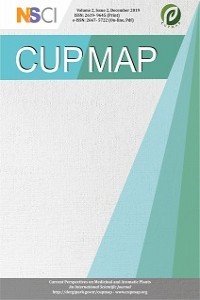Identification and Authentication of Microbes Causing Urinary Tract Infection and Detection of Antibacterial Activity for Methanolic Extract of Senna alexanderina against these Pathogenic Bacteria in Khartoum State, Sudan
Identification and Authentication of Microbes Causing Urinary Tract Infection and Detection of Antibacterial Activity for Methanolic Extract of Senna alexanderina against these Pathogenic Bacteria in Khartoum State, Sudan
urinary tract infection methanolic extract, Senna alexanderina, Pathogenic Bacteria, Microbes,
___
- References 1. Abeysinghe P.D. (2010). Antibacterial activity of some medicinal mangroves against antibiotic resistant pathogenic bacteria. Indian Journal of Pharmaceutical Science, 72, 167-72
- 2. Dole C. (2004). In the shadows of medicinal and modernity medicinal integration and secular histories of religious healing in turkey journal culture. Medicinal Psychiatry, 28(3),255-80.
- 3. Gezici S. and Sekeroglu N. (2019). Current perspectives in the application of medicinal plants against cancer: novel therapeutic agents. Anti-Cancer Agents in Medicinal Chemistry (Formerly Current Medicinal Chemistry-Anti-Cancer Agents), 19(1), 101-111.
- 4. Gomez MR, Cerutti S, Sombra LL, Silva MF and Martı´nez LD. (2007). Determination of heavy metals for the quality control in Argentinian herbal medicines by ETAAS and ICP-OES. Food Chem Toxicol 45:1060–1064.
- 5. Kanwar K., Pandey R., Gezici S., Azmi W. (2019). Enzymes as competent tool for efficient management of pathogen’s biofilms. Annals of Phytomedicine, 8(1), 70-81.
- 6. Kavanagh F. (1972). Analytical Microbiology, Vol II, Academic Press, New York and London, pp. 11.
- 7. Miles A. A. and Misra S. S., (1938). Estimation of bacterial power of blood, J Hygiene (Lond) 38: 732-49.
- 8. Saranraj P. and Sivasakthivelan P. (2012). Screening of Antibacterial Activity of the Medicinal Plant Phyllanthus amarus Against Urinary Tract Infection Causing Bacterial Pathogens, Applied Journal of Hygiene, 1(3), 19-24.
- 9. Selim S. A., El Alfy S. M., Abdel Aziz M. H., Mashait M. and Warrad M. F. (2013). Antibacterial activity of selected Egyptian ethnomedicinal plants, Malaysian Journal of Microbiology, 9(1), pp. 111-115.
- 10. Sharma A., Verma R. and Ramteke P. (2009). Antibacterial Activity of Some Medicinal Plants Used by Tribals Against Uti Causing Pathogens, World Applied Sciences Journal, 7(3), 332-339.
- 11. Shida W., Tateishi H., Tahara, Y. Fujita, M. Husham Majeed Alsaadi D., Watanabe M., Koga R., Radwan M.O., Ciftci H.I., Gezici S., Kurauchi Y., Katsuki H., Otsuka M., Sugimura K., Wada M., Sekeroglu N., Watanabe T. (2019). Antileukemic Activity of Twig Components of Caucasian Beech in Turkey. Molecules, 24(21), 3850.
- 12. Viswanathan S. and Nallamuthu T. (2012). Phytochemical screening and antimicrobial activity of leaf extracts of Senna alexandrina Mill. against human pathogens, International Journal of Current Science, 2, 51-56.
- 13. World Health Organization (WHO), (1988). The international pharmacopoeia, 3rd ed. Vol. 3. Quality specifications. Geneva.
- ISSN: 2619-9645
- Yayın Aralığı: Yılda 2 Sayı
- Başlangıç: 2018
- Yayıncı: Nazım ŞEKEROĞLU
Researches on Cultivation of Medicinal and Aromatic Plants in Kayseri
Ahmet YENİKALAYCI, Kemal GÜL, Mahmut GÜNEŞ
Bekir TOSUN, Tahsin KARADOĞAN, Arif ŞANLI
The Effect of Corchorus olitorius L. Extract on Viability of Breast Cancer Cells: A friend or a foe?
Günsu SOYKUT ÇAĞSIN, Eda BECER, İhsan ÇALIŞ, Seda VATANSEVER
Olcay ARABACI, Çiğdem SÖNMEZ, Amir Hasan TAGHİLOOFAR, Uğur TAN, Emine BAYRAM
Olcay ARABACI, Uğur TAN, Hafize SERT, Burak BAYKAL, Mukaddes TOPÇU, Mestan YUSMAK
Slovak Chamomile Varieties and their Comparison of Natural Components
Abubker O. BABİKER, Areeg A. ABDELWAKEEL, İbrahim F. AHMED, Ahmed ELSHİKH
Višnja OREŠČANİN, štefica FİNDRİ GUSTEK, İvan FİSTONİC, Damir HODZİC, Josip VALETİC, Josipa RODİC
Hanife ARDAHANLI, Süleyman GÜL
The Efficiency of Bioapifit® Wound Care Ointment in the Treatment of Diabetic Foot Ulcers
Višnja OREŠČANİN, Zrinka MİHALİC, Josipa RODİC, štefica FİNDRİ GUSTEK
